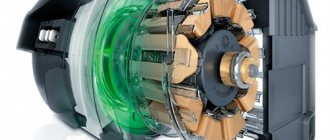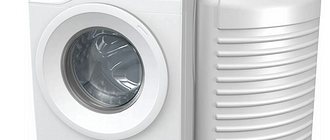Many buyers, when choosing equipment, do not pay attention to the power consumption of the dishwasher (hereinafter also referred to as PMM, dishwasher). They are more interested in the version of the PMM (built-in, free-standing or tabletop), the design and the number of dishes that the device can wash at one time.
The energy efficiency of large household appliances is improving year after year.
The electricity consumption of a dishwasher is one of the important characteristics that must be taken into account when purchasing a PMM, since utility tariffs are increasing from year to year.
Power and energy consumption: what's the difference?
Most people confuse these two indicators. In fact, there is a big difference between them. Energy consumption is the amount of energy that the dishwasher uses in one hour of operation . At the same time, individual parts of the PMM do not work continuously during this time.
For example, a tubular electric heater (hereinafter also referred to as a heating element) turns off after heating the water to the desired temperature. This will take him, for example, 10 to 15 minutes. The drain pump runs for a maximum of half an hour. At different stages of the operating cycle, different PMM nodes are involved, therefore the average energy consumption per hour of operation is determined. The calculation is carried out in kilowatt-hours (kW/h).
The energy consumption level is divided into classes - from A to G
Power is the amount of energy that the dishwasher takes from the electrical network in the event of simultaneous operation of all its components . How much electricity does a dishwasher use compared to its power? It turns out that the difference between the PMM power indicator and the energy consumption is very significant. Power is 2-3 times higher than the level of energy consumption, and its unit of measurement - kilowatt (kW) - is not tied to time . The cross-section of the electrical cable supplying electricity to the device depends precisely on the power that the dishwasher has.
What is the difference between power and energy consumption?
Many people confuse these indicators, but they are significantly different. You can notice this from the description of the characteristics of the PMM in the instructions. As a rule, the amount of energy consumption is less than power. What causes this? To understand the difference, you need to know how a dishwasher works. The fact is that during the dishwashing cycle, different components are involved at different stages.
Schematic representation of a dishwasher, which shows the main parts that consume electricity
Electricity is mainly consumed by:
- Electric water heater (hereinafter also referred to as heating element). In 10-15 minutes it heats the liquid to the temperature specified by the program. Heating can be carried out both up to +40℃ and up to +70℃. But the heating element does not work constantly; after heating the water to the required temperature, the thermistor (temperature sensor) sends a signal to the control unit and the part turns off. The power of the electric heater can reach 2.5-2.8 kW.
- Forced drying system for dishes . It also includes an electric heater, but it heats the air, which is forced by a fan into the working chamber. Convection drying takes longer, but it also consumes 35-40% less electricity than during forced drying. This process also takes only part of the total operating time of the PMM.
- The circulation pump (pump) supplies liquid under pressure to the spray arms throughout the entire time of washing and rinsing kitchen utensils. This part works the longest during the operating cycle. But the power of the pump is small - around 100 W.
- The drain pump removes dirty liquid from the PMM into the sewer. It does not work for long and has the smallest power, up to 30 W.
The circulation pump and flow-through electric heater are the parts that consume the most electricity in a dishwasher
Energy consumption is the amount of electricity used, expressed in kilowatts (kW), per hour of operation of the device. This indicator is expressed in kW/h units. But during this hour, individual energy-consuming parts can work in a matter of minutes. This is why the amount of energy consumption is much less than the power level.
The level of energy consumption depends on how much water is used for a full wash cycle, as well as on the selected program. The more water in the tank, the more energy and time is spent heating it. Work programs also differ greatly in the duration of dishwashing.
Power is the maximum amount of energy consumed in the shortest period of time (1 second), provided that all parts and systems of the dishwasher are working. Expressed simply in kilowatts (kW).
The two above indicators are usually recorded both on the PMM body itself and in the instructions for the device. They reflect a complete picture of how much electricity the dishwasher consumes. The efficiency of different dishwasher models is classified according to the level of annual energy consumption, and not by power.
Energy efficiency is divided into classes, the most efficient of which is A, the most expensive and outdated is G.
Electricity consumption classification
PMMs are classified not by power, but by energy consumption. All large household appliances have labels that indicate the level of energy efficiency of models of various brands - Bosch, Siemens, Electrolux and many others. The information on the tags of almost all products is systematized in the same way (see figure).
The sticker contains comprehensive information about the technical characteristics and operating efficiency of dishwashers
Interesting fact: such an indicator as power is not on the tags. There are energy efficiency classes. The most energy-efficient products are assigned classes A+++, A++, A+, and A.
Depending on the class, electricity consumption increases as follows:
- A+++ – 0.63 kW/h and less;
- A++ – from 0.65 to 0.75 kW/h;
- A+ – from 0.75 to 0.85 kW/h;
- A – from 0.85 to 1.05 kW/h;
- B – around 1.05–1.2 kW/h;
- C – in the range of 1.2–1.5 kW/h;
- D, E – from 1.5 to 2.3 kW/h.
Information about classes F and G is no longer relevant today. Most buyers choose products with classes from A to A+++.
Energy efficiency classes
Dishwasher power consumption (kilowatts) is divided into 7 groups, which simplify the selection of the most suitable equipment. Latin letters are used for designation:
- A. This rating is the highest and means low energy consumption. The average figure is 0.7-1.05 kW. The advent of modern equipment has led to the use of classes A+ and A++, the power of which is 0.6 and 0.4 kW, respectively.
- B. Equipment with a similar rating has an indicator of 1.07-1.1 kW.
- C. In the manufacture of dishwashers, component elements can be used, the total power of which is 1.1-1.5 kW.
- D and E. This class is an average rating, since the power consumption is 1.5-2.3 kW.
- F and G. The lowest energy consumption rating defines a dishwasher with more than 2.7 kW of power. This category includes exclusively old models.
It is recommended to purchase models of class A+ and A++. The cost of electricity is constantly rising, low consumption allows you to reduce costs. Despite the low power, dishwashers cope with the tasks.
All dishwashers are divided into 3 main classes:
- Basic models. They have a minimum set of programs and a noise level of 50 dB.
- Functional devices. To effectively clean dishes, the equipment is equipped with a considerable number of programs.
- Advanced. Only expensive models have a large set of programs. Moreover, some are related to the analysis of water hardness and other issues.
Modern models are able to perform more operations per cycle, while consuming less energy. Much depends on the flow rate; too high a power can lead to overheating of the wiring.
What components and parts affect energy consumption?
Each dishwasher consists of a certain set of components and parts. They all consume a certain amount of energy. The level of its consumption depends on the following components:
- The heating element is the most energy-consuming element. The power of this device that heats water for washing dishes varies widely and can exceed 2 kW. Its operating time depends on the water temperature level that is set in the selected program. The temperature range is quite wide - from +30...35 ℃ to +70...80 ℃. PMM models with forced drying have another heater that increases the air temperature, as well as a fan. Unlike devices with convection drying, such dishwashers have a higher energy consumption level.
- Circulation pump - pumps liquid into the nozzles of the spray arms, and also ensures the reuse of water in order to save it. The power of this pump is low, approximately 100 W. The longer the dishwashing program lasts, the more energy the appliance consumes.
- Drain pump - pushes waste fluid into the sewer. Pump power – from 30 to 40 W. The duration of its operation depends on the amount of dirty water that needs to be removed from the PMM.
Dishwasher drain and circulation pumps (bottom view)
Energy consumption indicators depend on several other factors:
- The amount of liquid consumed per washing cycle. The indicator ranges from 7-15 liters. The more water, the longer it needs to be heated. The operating time of the drain pump also depends on the volume of water.
- Duration of the washing process. The time depends on the program selected by the user and varies widely - from 40 minutes to 4 hours. This indicator affects the total energy consumption of the circulation pump.
- Basket sizes. This indicator determines the number of tableware that can be washed in one cycle, and affects all others. If we compare narrow and full-size PMMs, the latter will require more water to operate, as well as a more powerful electric heater and pump for sprinklers. The units of small tabletop dishwashers have the lowest energy consumption and power.
The countertop dishwasher is the least productive, but the most economical of all types of PMM
Tips for reducing power consumption
There are rules for proper operation that allow you to save energy:
- Most dishwasher models have a “half load” mode. It is worth using it because it saves approximately 25-30% of water and electricity.
- It is best to postpone the washing process until the evening or even at night. For example, during the day you can put the dishes in and run the “delayed start” program. Cold water will fill the machine, but washing will not occur. In a few hours, the water will warm up to room temperature, and at night (when the electricity tariff is lower) the machine will turn on and operate quietly.
- Regularly clean the heating elements of the washing unit from scale. If it becomes covered with a thick layer of mineral deposits, it will heat much worse and longer than necessary, and will waste a lot of extra energy. In this case, it may completely fail due to overheating.
- Do not allow food to dry out on plates. It’s better to put them in a large container with water, let them soak, and then you can wash everything at once.
So, it is important for the buyer to decide on the power of the dishwasher he is purchasing, because both too little and too much power are not an acceptable solution. Our review revealed some simple principles that will narrow the search field and allow you to make the best choice.
Useful tips for using dishwashers
If you properly allocate resources and operating time of the dishwasher, you can save energy. Follow the recommendations below:
- Wash dishes at night when electricity rates are lower. To do this, you need to have a two-tariff electric meter and a PMM, which has a delayed start function. In the evening, turn on the device, select a washing program, start it and wait until the water in the tank finishes filling. Then stop the program and enable delayed start. Firstly, in the time before restarting, the water will have time to warm up to room temperature and less energy will be needed to heat it up. Secondly, the work cycle will be performed at night, when the electricity tariff is lower.
- Don't keep dishes dirty for too long , as dried food waste makes them more difficult to clean. You will have to run a program with soaking, double rinsing and washing at a higher temperature. Naturally, such a choice will lead to more energy consumed.
- Choose your washing program wisely - do not wash slightly soiled dishes with hot water for too long. For effective cleaning, an accelerated mode at a liquid temperature of +30...40 ℃ may be sufficient.
- Try to load the dishwasher as much as possible . Running a partially loaded PMM is impractical due to inefficient use of electricity. But if your model has a half-load function, use it.
- Regularly descale the heating element of your dishwasher. If the heater is covered with a layer of scale, it heats the water much worse, while consuming the same power as before.
Today, stores offer a wide selection of dishwashers for any family. When choosing, be sure to pay attention to energy efficiency rating labels - this will save you from unnecessary costs when paying bills in the future. You will find tips on choosing dishwashing equipment in our other article.
How to save energy
A significant part of the electricity is spent on heating water. You can often find recommendations to connect the machine directly to the hot water system in the house. After all, the dishwasher analyzes the temperature of the incoming water and compares it with the set one; if there is a difference, it turns on the heating. How effective are these savings? This is determined by the origin of the hot water in a particular home.
- If a boiler provides hot water, then it is reasonable to compare its power with the power of heating water in a dishwasher. If the boiler consumes less power, there is every reason to use its hot water.
- If you live in a standard house with hot water supply, you need to compare the cost of a cubic meter of cold and hot water. It often happens that it is cheaper to heat cold water in the dishwasher than to connect hot water.
- If the apartment has a gas water heater, then given the low cost of gas, it makes sense to use water heated in the water heater.
In order for your dishwasher to use less electricity and at the same time remain efficient, it is advisable to listen to the following recommendations.
- Dishes are washed with a delayed start. Turn on the machine until its water tank is completely filled with water and pause the program so that the machine turns on again at night. On the one hand, in a few hours the water in the tank will warm up to room temperature and it will need to be heated less, on the other hand, the nightly electricity tariff is much lower.
- Do not accumulate heavily soiled dishes. Residues of food dried on the plates will require a lot of energy to put the dishes in order. You will need very hot water and double rinsing. All this is very energy-consuming.
- As mentioned above, it is better to purchase machines with a built-in heat exchanger.
- It is necessary to select the most optimal dishwashing modes. If the dishes are not very dirty, you can turn on the wash at 30°C and use the shortest program.
- Advanced models have beneficial optional modes, such as “accelerated washing”. The entire washing cycle takes 30 minutes. The disadvantage of such devices is their small capacity of dishes. A small family of 4 people can use such dishwashers.
It must be taken into account that new technologies are rapidly advancing the process, and new types of machines appear on the market that work more efficiently and with low energy resources.
Main features of Electrolux dishwashers
The Electrolux brand is known throughout the world as a brand of household appliances for various purposes, with factories located in many countries around the world, with its head office in Sweden. The company's product line includes refrigerators and cooktops, ovens and hoods, and the Comfort Lift brand dishwasher (with lower basket lifting technology) made a splash at the 2021 international exhibition held in Germany. The Swedish company is constantly improving its models, so Electrolux dishwashers are deservedly popular among users; their main features are:
- variety in type of execution and technical characteristics;
- functionality and the ability to independently diagnose faults;
- ease of management and maintenance;
- energy efficiency;
- affordable price.
The dishwasher can be used to wash dishes for various purposes.
Tips for choosing
So, if you have not yet purchased a dishwasher and are just looking to buy one and are calculating the possible costs of using it, then when choosing a dishwasher, try to pay attention to the following:
- Regarding the reliability of the dishwasher, first of all, you should take a closer look at the most well-known companies and brands; they try very hard to monitor the quality of the products; if they offer you unknown brands, try reading reviews. The most popular dishwashers are INDESIT, BOSCH, CANDY, HOTPOINT/ARISTON, SIEMENS, WHIRLPOOL, BEKO.
- Look to which energy consumption class this dishwasher model belongs to.
- See how much electricity the machine consumes in 1 cycle (1 wash)
- Find out how much water is consumed in 1 cycle.
- Study the design features of the dishwasher, as washing efficiency may vary for different models. Pay attention to the rail with holes that spray water; the holes on it should be made at different angles, and their number on both sides should be at least 6.
- Choose a model with active drying; the turbo drying mode consumes more energy, the condensing mode uses less energy, but stains may remain.
Read
How much electricity does an air conditioner consume?











